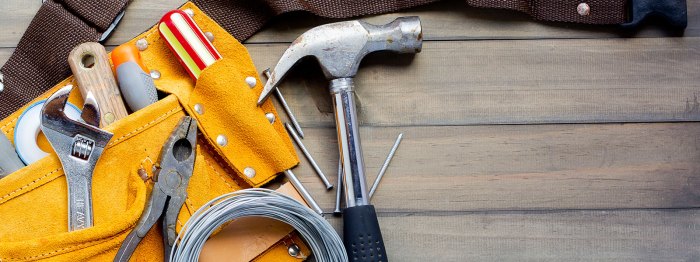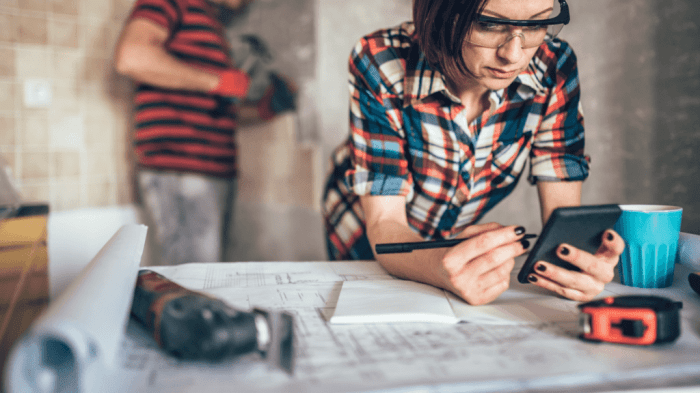
Embarking on a home improvement project can be both exciting and daunting. Whether you’re tackling a simple repair or a full-scale renovation, having the right tools can make all the difference. From essential hand tools to powerful power tools, this comprehensive guide will equip you with the knowledge to assemble a toolbox that will empower you to tackle any home improvement task with confidence and efficiency.
This guide will delve into the essential tools that every DIY enthusiast should have in their arsenal. We’ll explore the importance of each tool, its specific applications, and the benefits it offers. By understanding the tools you need and how to use them effectively, you can transform your home improvement projects from daunting challenges into rewarding experiences.
Essential Hand Tools

Having a well-stocked toolbox with essential hand tools is crucial for any DIY enthusiast. These tools are versatile and can handle a wide range of tasks, making them indispensable for tackling home improvement projects, from simple repairs to more complex renovations.
Essential Hand Tools
A basic set of hand tools is essential for any DIYer. These tools are versatile and can be used for a variety of tasks, from simple repairs to more complex projects. Here is a list of essential hand tools that every DIYer should have:
- Hammer: A hammer is a must-have tool for driving nails, removing nails, and breaking apart materials. Choose a hammer with a comfortable grip and a weight that is appropriate for your needs.
- Screwdriver Set: A screwdriver set is essential for driving and removing screws. A set should include both Phillips and flathead screwdrivers in a variety of sizes.
- Pliers: Pliers are versatile tools that can be used for gripping, bending, and cutting wire. A set of pliers should include needle-nose pliers, channel-lock pliers, and wire cutters.
- Wrench Set: A wrench set is essential for tightening and loosening nuts and bolts. A set should include both open-end and combination wrenches in a variety of sizes.
- Level: A level is used to ensure that surfaces are horizontal or vertical. A level can be used for a variety of tasks, such as hanging pictures, installing shelves, and building cabinets.
- Tape Measure: A tape measure is used to measure distances and lengths. Choose a tape measure with a clear, easy-to-read scale and a sturdy locking mechanism.
- Utility Knife: A utility knife is used for cutting a variety of materials, including cardboard, tape, and rope. A utility knife should have a sharp, replaceable blade.
- Stud Finder: A stud finder is used to locate studs in walls and ceilings. This is essential for hanging heavy objects, installing shelves, and mounting cabinets.
Power Tools for Efficiency
Power tools are essential for any DIYer looking to save time and effort on home improvement projects. They can handle tasks that would be difficult or impossible with hand tools alone, making them a valuable investment for anyone who wants to tackle more complex projects.
Essential Power Tools for DIYers
Power tools come in various types, each designed for specific tasks. Here are some essential power tools that every DIYer should consider having in their arsenal:
- Drill/Driver: This versatile tool is used for drilling holes and driving screws. It can handle a wide range of materials, from wood to metal, and is a must-have for any home improvement project. Modern drill/drivers often feature adjustable torque settings for precise control and a variety of clutch settings to prevent over-tightening screws.
- Circular Saw: A circular saw is used for making precise, straight cuts in wood and other materials. It is ideal for cutting plywood, lumber, and other sheet goods, making it a valuable tool for building cabinets, shelves, and other woodworking projects. Circular saws often have adjustable depth settings and bevel capabilities, allowing you to make angled cuts.
- Jigsaw: A jigsaw is used for making curved and intricate cuts in wood and other materials. It is ideal for cutting out shapes, making decorative cuts, and even cutting along curves in sheet goods. Some jigsaws feature adjustable blade angles and speeds, allowing for greater control and precision.
- Sander: A sander is used for smoothing surfaces and removing imperfections. It comes in various types, including orbital sanders, belt sanders, and random orbital sanders. Each type is designed for different applications, from smoothing rough wood to removing paint and rust. Sanders can be used to prepare surfaces for finishing or to create a smooth, even surface for painting.
- Multi-tool: A multi-tool is a versatile tool that combines several different functions in one. It often includes a saw, a sander, a scraper, and a knife, making it a valuable tool for a wide range of tasks. Multi-tools are great for making small cuts, sanding tight corners, and removing old caulk.
Measuring and Marking Tools
In the world of DIY, precision is key. Accurate measurements and markings are the foundation of any successful home improvement project. Whether you’re cutting wood, installing tile, or hanging a picture, taking the time to measure and mark correctly will save you time, frustration, and costly mistakes.
Tape Measure
A tape measure is an essential tool for any DIYer. It’s used to measure the length, width, and depth of objects and spaces. Most tape measures are retractable, making them easy to store and carry. They also feature a hook at the end, which can be used to secure the tape measure to a surface or to measure around curves.Here are some tips for using a tape measure:
- Always start at the zero mark when measuring.
- Pull the tape measure out slowly and smoothly to avoid bending or breaking it.
- Read the measurements carefully, ensuring that you are using the correct units (inches or centimeters).
Measuring Stick
A measuring stick is a straight, rigid tool that is used to measure longer distances. They are typically made of wood or metal and are available in various lengths. Measuring sticks are often used in conjunction with a tape measure, as they can provide a more accurate measurement for longer distances.Here are some tips for using a measuring stick:
- Align the measuring stick with the object or space you are measuring.
- Ensure that the measuring stick is level and straight.
- Mark the desired length on the measuring stick with a pencil or marker.
Chalk Line
A chalk line is a tool used to create straight lines on a surface. It consists of a spool of string coated with chalk, a mechanism for winding and unwinding the string, and a handle for holding the tool. Chalk lines are commonly used in construction and home improvement to mark out walls, floors, and other surfaces.Here are some tips for using a chalk line:
- Snap the chalk line taut between two points.
- Release the string to create a straight line of chalk on the surface.
- Repeat this process as needed to create multiple lines.
Pencil
A pencil is an indispensable tool for marking and transferring measurements. It’s essential for transferring measurements from a tape measure or measuring stick to a surface. A pencil can also be used to mark cutting lines, installation points, and other important details.Here are some tips for using a pencil:
- Use a sharp pencil to ensure accurate markings.
- Press lightly to avoid damaging the surface.
- Mark clearly and legibly.
Safety Equipment
Home improvement projects can be rewarding, but they also come with inherent risks. Using the right safety equipment is crucial to protecting yourself from injuries and ensuring a safe and enjoyable DIY experience. Investing in quality safety gear is an investment in your well-being and peace of mind.
Essential Safety Equipment
Investing in a comprehensive set of safety gear is essential for any DIY enthusiast. These tools can protect you from a range of hazards, ensuring a safe and enjoyable experience.
- Safety Glasses: Protect your eyes from flying debris, dust, and chemical splashes. Look for glasses with impact-resistant lenses and side shields for maximum protection.
- Gloves: Protect your hands from cuts, abrasions, and chemical exposure. Choose gloves based on the task at hand, whether it’s handling tools, working with chemicals, or protecting your hands from rough surfaces.
- Ear Protection: Protect your hearing from loud noises generated by power tools. Use earplugs or earmuffs to reduce noise levels and prevent potential hearing damage.
- Respirator: Protect your respiratory system from dust, fumes, and other airborne particles. Choose a respirator with the appropriate filter for the specific hazards you’re working with.
Safety Glasses
Safety glasses are essential for protecting your eyes from various hazards encountered during home improvement projects.
- Flying Debris: When using power tools, hammering, or cutting materials, flying debris can easily injure your eyes. Safety glasses act as a barrier, preventing these projectiles from reaching your eyes.
- Dust and Particles: Many home improvement tasks generate dust and fine particles that can irritate your eyes. Safety glasses help to prevent these particles from entering your eyes, reducing the risk of irritation and infection.
- Chemical Splashes: When working with chemicals, accidental splashes can cause serious eye damage. Safety glasses provide a protective barrier, minimizing the risk of chemical exposure to your eyes.
Gloves
Gloves are an essential part of protecting your hands from a range of hazards during home improvement projects.
- Cuts and Abrasions: Handling sharp tools, working with rough materials, or handling heavy objects can lead to cuts and abrasions. Gloves provide a protective layer, reducing the risk of these injuries.
- Chemical Exposure: Working with paints, solvents, and other chemicals can expose your hands to harmful substances. Gloves create a barrier, preventing direct contact with these chemicals and minimizing the risk of skin irritation or absorption.
- Heat and Cold Protection: Some tasks, such as working with hot tools or handling cold materials, require gloves for heat or cold protection. Gloves provide insulation, protecting your hands from extreme temperatures.
Ear Protection
Ear protection is crucial for safeguarding your hearing during home improvement projects, particularly when using power tools.
- Noise Exposure: Power tools, such as saws, drills, and sanders, generate high levels of noise that can damage your hearing over time. Ear protection helps to reduce the intensity of these noises, protecting your hearing from potential damage.
- Hearing Loss: Prolonged exposure to loud noises can lead to hearing loss, a condition that can significantly impact your quality of life. Using ear protection regularly helps to prevent this type of hearing loss.
- Tinnitus: Tinnitus, a condition characterized by ringing or buzzing in the ears, can be caused by exposure to loud noises. Ear protection helps to reduce the risk of developing tinnitus.
Respirator
A respirator is essential for protecting your respiratory system from dust, fumes, and other airborne particles that can be harmful to your health.
- Dust and Particles: Many home improvement tasks, such as sanding, sawing, and drilling, generate dust and fine particles that can be inhaled. A respirator filters out these particles, preventing them from entering your lungs.
- Fumes and Gases: Working with paints, solvents, and other chemicals can release harmful fumes and gases. A respirator with the appropriate filter can remove these contaminants from the air you breathe, protecting your respiratory system.
- Allergens: People with allergies can experience respiratory problems when exposed to allergens like pollen, mold, and dust mites. A respirator can help to filter out these allergens, reducing the risk of allergic reactions.
Specialized Tools for Specific Projects
While general-purpose tools are essential for most DIY tasks, specialized tools can significantly enhance your work, ensuring precision, efficiency, and professional-quality results. These tools are designed for specific applications, providing specialized features and functionalities that make certain tasks easier and more effective.
Specialized Tools for Cutting
Specialized cutting tools are indispensable for various home improvement projects, enabling precise and clean cuts for different materials.
- Miter Saw: This powerful tool is perfect for making precise angled cuts, ideal for cutting molding, trim, and picture frames. The miter saw’s adjustable cutting angle and fence ensure accurate cuts, resulting in professional-looking joints.
- Drywall Saw: Designed specifically for cutting drywall, this saw features a thin, serrated blade that easily cuts through drywall without causing damage. The drywall saw’s narrow blade allows for precise cuts around electrical boxes and other obstacles.
- Tile Cutter: For cutting ceramic and porcelain tiles, a tile cutter is an essential tool. The tile cutter’s scoring mechanism creates a precise cut line, allowing you to snap the tile cleanly and accurately. This tool is perfect for creating straight cuts and intricate patterns in tiles.
Specialized Tools for Plumbing
Plumbing projects often require specialized tools for tackling various tasks.
- Pipe Wrench: This heavy-duty wrench is used for gripping and turning pipes, ideal for installing and removing plumbing fixtures. The pipe wrench’s adjustable jaws provide a secure grip, allowing you to apply significant torque for tightening and loosening pipes.
- Tubing Cutter: For cutting copper and plastic tubing, a tubing cutter provides clean and precise cuts. The tubing cutter’s rotating blade creates a smooth, burr-free cut, ensuring a leak-free connection.
- Drain Snake: A drain snake is a flexible cable with a hook or auger at the end, designed to remove clogs from drains. By inserting the snake into the drain and rotating it, you can break up clogs and clear the blockage.
The Home Improvement Straw

The term “Home Improvement Straw” is a playful metaphor representing a simple yet essential tool for DIY enthusiasts – a straw used for sipping drinks while working on home improvement projects. This seemingly insignificant item can significantly enhance the DIY experience, promoting both convenience and efficiency.
Benefits of the Home Improvement Straw
The “Home Improvement Straw” offers several practical benefits that contribute to a smoother and more enjoyable DIY journey. Staying hydrated is crucial during physically demanding tasks, and the straw allows you to easily take sips of your beverage without interrupting your work. This is particularly beneficial when working with tools or materials that require precise movements or extended periods of concentration.
“The Home Improvement Straw is a game-changer. I used to have to constantly put down my tools to grab a drink, which slowed me down. Now, I can stay hydrated and keep working without missing a beat!”A satisfied DIYer.
As you embark on your home improvement journey, remember that having the right tools is only part of the equation. Safety should always be your top priority. Always wear appropriate safety gear, read instructions carefully, and never hesitate to seek guidance from experienced professionals if needed. With the right tools, knowledge, and a touch of DIY spirit, you can transform your home into a haven that reflects your unique style and personality.
Helpful Answers
What are the most important hand tools for a beginner DIYer?
A hammer, screwdriver set, pliers, wrench set, level, tape measure, utility knife, and a stud finder are essential for most basic home improvement tasks.
What is the difference between a drill and a driver?
A drill is used for making holes, while a driver is designed for driving screws. Many tools combine both functions into a drill/driver.
How do I choose the right safety glasses for my projects?
Choose safety glasses that provide protection from dust, debris, and flying objects. Look for glasses that meet ANSI Z87.1 standards.




